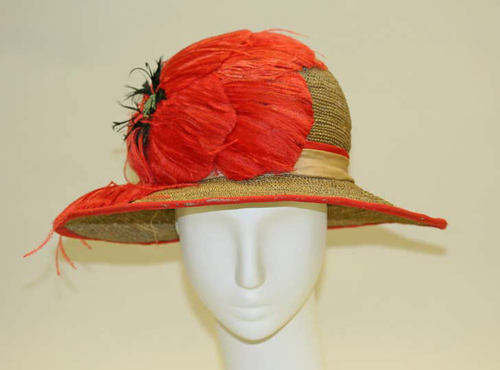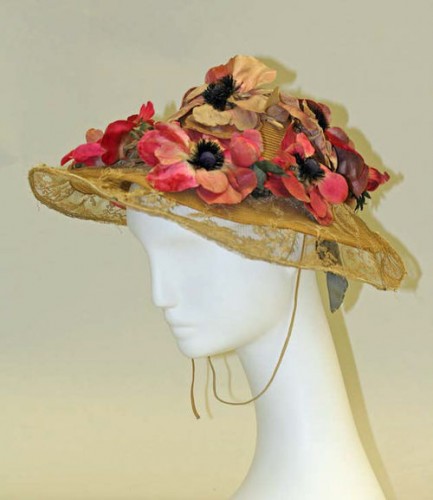Today is ANZAC day, the anniversary of the first major NZ and AU action during WWI. Everywhere across New Zealand, Australia, and some of the rest of the Pacific, people will have little poppies pinned to their lapels in memory of those who served, and those who dies.
Remember what happened, so that we never again let ourselves be led into a situation where such a tragic loss of life becomes inevitable.



Two lovely hats! Thank you kindly.
Lovely hats.
“The only thing necessary for the triumph of evil is for good men to do nothing.” -Edmund Burke
I like the hats, too. I loved living in Canada where everyone wore poppies on days remembering those fallen and the hurt of their families. The sight of all of those people wearing red on their chests as though their own hearts had been wounded is the sort of thing that affixes the desire for peace.
I wish that more US citizens learned more about the awful losses sustained by other countries’ citizens. When I learned about Dieppe (a sort of dress rehearsal for WWII’s D-Day were Canadian troops were practically abandoned in France by American and British forces), I realised how much sorrow had been erased from our American textbooks.
But I truly believe that if we truly remember and commemorate, rather than glorify WWI and WWII and all the other sad wars (aren’t they all sad?), we will keep actively working toward peace and kindness.
I am so glad that NZ seems to do it right. In Germany, I volunteered at the Army hospital where US servicemembers were taken directly after sustaining wounds in Iraq and Afghanistan. None of them really wanted hero worship. They were all trying the process the death of their friends, or the deaths that they had causes to the Iraqis or Afghans. Most military sorts I have met cringe when told”thank you for your service.”
I watched a commercial for the Honor Flight, I program that sends WWII vets to Washington DC for free to visit their memorial and to bring closure. It’s so frustrating watching people say ‘thank you’, when all those poor old men and women want to do is have time to feel sad for their friends.
The Army even toasts the Indian Wars, where US troops helped commit a genocide. This is the wrong thing to do.
I think that wearing poppies is exactly how it should be done.
Rant over. Thanks for the opportunity to post about something so close to me. I miss those silent and important pleas for peace. I am so glad (can I be glad about this?) that the tradition keeps in New Zealand.
Sorry I wrote too much…
Oh no! I love your insight – and that this post sparked a real conversation.
I’m also glad that we keep this tradition. I think we do it right too, but of course this is my native culture (a few of my relatives were ANZACs) and I’m probably biased, so it’s cool to hear the same perspective from someone whose cultural perspective is slightly different.
The fact that we’re still processing the loss of our loved ones in WWI and WWII, even after two or three generations, is something we as a species should be mindful of.
I never thought of that: we are still processing deaths from 100 years ago. How awful. And how important to attempt kindness in all things, even in small ways.
Thank you for your insights about Canada. My first real introduction to WWI history was through Montgomery’s later “Anne” books. Rilla of Ingleside, and the foreshadowing in Anne of Ingleside and Rainbow Valley still bring me to tears every time. WWI was almost completely unmentioned in any history I was taught in school.
As an outsider, I find NZ’s acknowledgement of Anzac day fascinating. It’s definitely more balanced, and educational than any similar event in the US, but there is still a big element of romanticisation of ‘the Greatest Generation’. WWI and the Anzacs were really so influential in creating the NZ national identity, that it starts to carry the same burden of expectations and glamorisation that the US gets with July 4 and the whole Pilgrim myth.
If I remember, WWI was very important in Canadian nationality, too, since it was the first war that Canadians formally entered themselves, rather than by royal degree. (Of course, there was still some royal nudging)
But I am thankful that many countries still attempt a balanced view.
I have mixed feelings about national mythology. It can put people together in a certain way, but I don’t like at all when myths are founded upon violence. (Except in the distant distant past. But we should be better by now)
I’d agree with that. There is quite a lot of romanticism, and while I’ve never thought of it as NZ’s version of Independence Day, it kind of is.
I think the reason it has an element of balance probably relates to NZ’s population size relative to the number of soldiers who died. The world wars took out a massive chunk of the population and pretty much every family in the country was affected, which meant the reality was too immediate to get sidelined.
This is a good rant. I have had many family members involved in both World Wars. The point about Anzac Day is to remember the huge losses and to think about how things might have been if they hadn’t occurred. Not every service person was (or is) a hero. Most were/are ordinary people who find themselves in an unbelievably awful situation thanks to the inability of the powers that be to resolve conflicts peacefully, or to an overpowering push for conquest from one or more countries. Oh, how I wish we could learn to do this without killing our young people!
It’s important to remember. And to try not to let it happen again. And again.
Thank you, Elise.
Thank YOU for your comments.
I’m not sold on the shape of the 19th century hat, though I do like the poppies, but I really like the 20s one. I’d like to make it with the hat part in a different colour, done so it resembles the poppy elements in Gustav Klimt’s paintings.
Beautiful hats and thoughtful comments. In my high school days, war poets were on the English curriculum and we all got to think hard about the contrast between the idealistic stuff and Wilfred Owen’s haunting descriptions. I think that at every dawn ceremony there are as many experiences as there are attendees – some buying into the romantic and idealisitc view of the whole thing, but most seeing it for what it is – let us not forget, lest we go there again…
When I was in high school (admittedly not long ago), we learned more about the wars and the horror the people went through, but the fact that war should be avoided was, unfortunately, not stressed as much as it probably should have been. There may be fewer issues if people were educated on just how horrid war is.
On a lighter note, I love poppies! They’re my favorite flower, and I’m smitten with the top hat (haha, get it?). The bottom reminds me somehow (hey, don’t ask how my mind works) of a rich lady’s interpretation of a bee-keeper’s hat.
That’s exactly why my few years of Canadian education were so striking to me: it was all about the horrors, and that it should be avoided. I wish that I could say it got better. When I was in high school in the 90s, my curriculum sounded about like yours. But I briefly taught high school in the aughts, and all mention of horror was out, it was all about ‘overcoming evil.’ (Very Bush2-era sentiments) I had just gotten back from a few-month stint in France, where all that generation was stunted, and you could still see battle scars in the earth. So it made the whole American-textbook thing especially awful.
Oh! and they are my favorite flower, too–right after red geraniums!